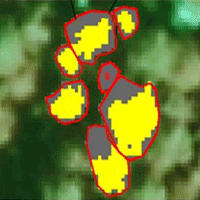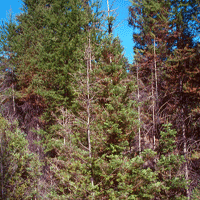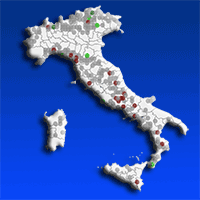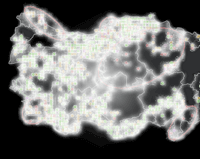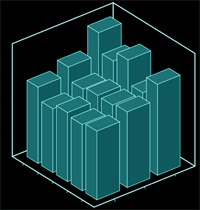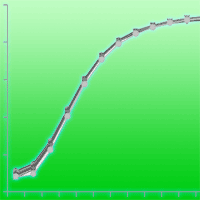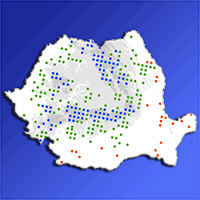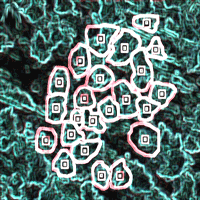
Estimating crown defoliation of Scots pine (Pinus sylvestris L.) trees using small format digital aerial images
G Mozgeris (1) , A Augustaitis (2)
iForest - Biogeosciences and Forestry, Volume 6, Issue 1, Pages 15-22 (2013)
doi: https://doi.org/10.3832/ifor0705-006
Published: Jan 14, 2013 - Copyright © 2013 SISEF
Research Articles
Collection/Special Issue: IUFRO 7.01.00 - COST Action FP0903, Kaunas (Lithuania - 2012)
Biological Reactions of Forest to Climate Change and Air Pollution
Guest Editors: Elena Paoletti, Andrzej Bytnerowicz, Algirdas Augustaitis
Abstract
This study focuses on the possibilities of using small format digital aerial images for the estimation of tree crown condition. The test area was located in the eastern part of Lithuania where Scots pine (Pinus sylvestris L.) trees prevail and was photographed using a Canon EOS-1DsMark II digital camera installed on-board a SkyArrow ultra-light aircraft. The camera lenses were adopted to capture images corresponding to conventional color-infrared photography. In addition, the test area was photographed using a large format digital frame aerial camera (Vexcel UltraCam D) installed on board a Rockwell Turbo Commander 690A high performance commuter aircraft. The ground sampling density of the images taken was around 9-10 cm. Crown defoliation was assessed in the field for more than 500 Scots pine trees located in 46 sample plots representing stands of trees that were either 65 years old or 170 years old. Spearman’s correlations coefficients were used to check for relationships between tree crown defoliation and image characteristics. The defoliation was also predicted using the non-parametric k-Nearest Neighbor method applied on data available from aerial images alone. The results were validated using the “Leave One Out” technique by comparing the obtained data with data from the field assessed defoliation rates. The prediction root mean square errors were calculated using data from the small format aerial images as being 11.5% for the younger trees, whereas those calculated using conventional aerial images were between 9.5 and 9.9%. The differences in predicted root mean square errors disappeared in the older stands and both methods produced errors of between 8.1 and 8.5%. Defoliation class was correctly predicted for approximately 84-88% of the older tree crowns and correctly for 75-85% of the younger tree crowns. These results showed that small format aerial images had the potential to predict defoliation in tree crowns and were comparable with results obtained using conventional aerial images. Their main advantage is that small format images are much cheaper to obtain than conventional images when the areas targeted are thousands of hectares in size.
Keywords
k-Nearest Neighbor, Small Format Aerial Images, Tree Crown Defoliation, Ultra-light Aircraft
Authors’ Info
Authors’ address
Institute of Forest Management and Wood Science, Aleksandras Stulginskis University, Studentu 11, LT-53361 Akademija, Kaunas distr. (Lithuania)
Laboratory of Forest Monitoring, Institute of Forest Management and Wood Science, Aleksandras Stulginskis University, Studentu 11, LT-53361 Akademija, Kaunas distr. (Lithuania)
Corresponding author
Paper Info
Citation
Mozgeris G, Augustaitis A (2013). Estimating crown defoliation of Scots pine (Pinus sylvestris L.) trees using small format digital aerial images. iForest 6: 15-22. - doi: 10.3832/ifor0705-006
Academic Editor
Elena Paoletti
Paper history
Received: Jul 26, 2012
Accepted: Nov 19, 2012
First online: Jan 14, 2013
Publication Date: Feb 05, 2013
Publication Time: 1.87 months
Copyright Information
© SISEF - The Italian Society of Silviculture and Forest Ecology 2013
Open Access
This article is distributed under the terms of the Creative Commons Attribution-Non Commercial 4.0 International (https://creativecommons.org/licenses/by-nc/4.0/), which permits unrestricted use, distribution, and reproduction in any medium, provided you give appropriate credit to the original author(s) and the source, provide a link to the Creative Commons license, and indicate if changes were made.
Web Metrics
Breakdown by View Type
Article Usage
Total Article Views: 56188
(from publication date up to now)
Breakdown by View Type
HTML Page Views: 47008
Abstract Page Views: 3131
PDF Downloads: 4580
Citation/Reference Downloads: 39
XML Downloads: 1430
Web Metrics
Days since publication: 4725
Overall contacts: 56188
Avg. contacts per week: 83.24
Citation Metrics
Article Citations
Article citations are based on data periodically collected from the Clarivate Web of Science web site
(last update: Mar 2025)
Total number of cites (since 2013): 7
Average cites per year: 0.54
Publication Metrics
by Dimensions ©
Articles citing this article
List of the papers citing this article based on CrossRef Cited-by.
References
Remote sensing of forest decline in the Czech Republic. Department of Physical Geography, Lund University, Sweden, pp. 47.
Gscholar
Needle reflectance of healthy and diseased spruce stands. In: “1st EARSeL Workshop on Imaging Spectroscopy” (Schaepman M, Schläpfer D, Itten KI eds). Remote Sensing Laboratories, University of Zurich (Switzerland) 6-8 October 1998. Impression Dumas, Saint-Etienne, France, pp. 271-283.
Gscholar
Climatic perturbation as a general mechanism of forest dieback. In: “Forest decline concepts” (Manion PD, Lachance D eds). St. Paul, Minnesota, USA, pp. 38-58.
Gscholar
Cartographical modeling of tree crown defoliation. Silviculture, transactions of Lithuanian forest institute and Lithuanian University of agriculture 1(53): 75-87. [in Lithuanian]
Gscholar
Color infrared aerial images to evaluate tree crown defoliation. In: Proceedings of the “4th International Scientific Conference on Rural Development”. Akademija, Kaunas r. (Lithuania), 15-17 October 2009. Vol. 4, Book 2, pp. 213-216.
Gscholar
Integration of LiDAR and digital aerial imagery for detailed estimates of Lodgepole Pine (Pinus contorta) volume killed by Mountain Pine Beetle (Dendroctonus ponderosae). Journal of Forestry 108 (3): 111-119.
Gscholar
Testing the simultaneous use of laser scanning and aerial image data for estimation of tree crown density. In: Proceedings of the 16th annual conference “Research for Rural Development”. University of Agriculture, Jelgava, Latvia, Vol. 1, pp. 201-207.
Gscholar
Remote sensing in forest health protection. FHTET Report No. 00-03, Forest Health Technology Enterprise Team, USDA Forest Service. Remote Sensing Applications Center, pp. 276.
Gscholar
Interpretation of SPOT-1 color composites for mapping of defoliation of hardwood forests by gypsy moth. Photogrammetric Engineering and Remote Sensing 55 (10): 1465-1470.
Gscholar
Users guide to the most similar neighbor imputation program Version 2. Gen. Tech. Rep. RMRS-GTR-96, Rocky Mountain Research Station, USDA Forest Service, Ogden, Utah, USA, pp. 35.
Gscholar
Aerial photography. Enciklopedija, Vilnius, Lithuania, pp. 248. [in Lithuanian]
Gscholar
Investigations of interpretation criteria of defoliated pine stands. Transactions of Lithuanian University of Agriculture 42: 21-23. [in Lithuanian].
Gscholar
Relation of Peperomia obtusifolia’s anomalous leaf reflectance to its leaf anatomy. Photogrammetric Engineering and Remote Sensing 43(9): 1183-1185.
Gscholar
Computer aided forest stand delineation and inventory based on satellite remote sensing. In: Proceedings of the SNS/IUFRO workshop “The usability of remote sensing for forest inventory and planning”. Umeå (Sweden) 26-28 February 1990, pp. 94-105.
Gscholar
Central European contribution to remote sensing and photogrammetry in forestry. In: Proceedings of the IUFRO centennial meeting “Forest resource inventory and monitoring and remote sensing technology”. Berlin (Germany) 31 August - 4 September 1992. Japan Society for Forest Planning Press, Faculty of Agriculture, Tokyo University of Agriculture and Technology, Saiwaicho, Fucku, Tokyo, Japan, pp. 196-212.
Gscholar
Forest Inventory. In: “Forest use and logistic: Textbook.” (Mažeika JA ed). Lithuanian University of Agriculture, Akademija, Kaunas r, Lithuania, pp. 227-287. [in Lithuanian].
Gscholar
Remote sensing and image interpretation (6 edn). John Wiley & Sons, Inc., USA, pp. 756.
Gscholar
Most similar neighbor: an improved sampling inference procedure for natural resource planning. Forest Science 41 (2): 337-359.
Gscholar
The use of k-NN method for estimating forest characteristics - the role of integrated information available from spatial images and conventional stand-wise forest inventory. Vagos 77 (30): 34-44. [in Lithuanian with English abstract]
Gscholar
Research on geometrical accuracy of orthophoto maps developed on the base of ultra-light aircraft imaging. Vagos 82 (35): 113-119. [in Lithuanian]
Gscholar
Aerial photography of Lithuanian forests: challenges and prospects for tomorrow. In: Proceedings of the Conference “Surveying Engineering and GIS”. Department of Geodesy, Faculty of Landscape management, Kaunas College, Mastaičiai, Lituania, pp. 49-54. [in Lithuanian with English summary]
Gscholar
Small format aerial images to estimate the pine crown defoliation. In: Proceedings of the “5 International Scientific Conference on Rural Development. Akademija, Aleksandras Stulginskis University (Lithuania) 24-25 November 2011, vol. 5, book 2, pp. 452-458.
Gscholar
Estimation of forest variables using satellite image data and airborne LiDAR. PhD thesis, Department of Forest Resource Management and Geomatics, Swedish University of Agricultural Sciences, Acta Universitatis Agriculturae Sueciae. Silvestrias, pp. 17.
Gscholar
Remote sensing of forest health. International Archieves of Photogrammetry, Remote Sensing and Spatial Information Sciences, Vol. 34, 8/W2, pp. 161-166.
Gscholar
Multi-source national forest inventory of Finland. In: Proceedings of the “IUFRO S4.02 Ilvessalo Symposium on National Forest Inventories”. Finnish Forest Research Institute, University of Helsinki (Helsinki), pp. 52-60.
Gscholar
The Finnish multisource national forest inventory - small area estimation and map production. Chapter 12. In: “Forest inventory: methodology and applications” (Kangas A, Maltamo M eds). Springer, Berlin, Germany, pp. 191-220.
Gscholar
Manual for integrated monitoring programme. Phase 1993-1996. Environmental Report 5. Environmental Data Centre, National Board of Waters and the Environment, Helsinki, Finland.
Gscholar
Manual on methods and criteria for harmonised sampling, assessment, monitoring and analysis of the effects of air pollution on forests. ICP, pp. 178.
Gscholar
The use of GIS and remote sensing for forest monitoring in Poland. In: “Remote Sensing and Computer Technology for Natural Resource Assessment” (Saramaki J, Koch B and Lund G, eds). Proceedings of the Subject Group S4.02-00 “Forest Resource Inventory and Monitoring” and Subject Group S4.12-00 “Remote Sensing Technology”, Volume II. IUFRO XX World Congress, Tampere (Finland) 6-12 August 1995. The University of Joensuu, Faculty of Forestry, Research Notes 48: 29-42.
Gscholar

